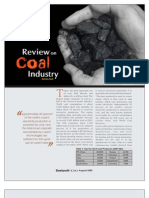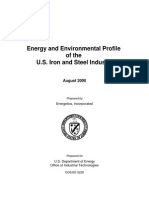Bauxite and Alumina
Bauxite and Alumina
Uploaded by
hobbiton04Copyright:
Available Formats
Bauxite and Alumina
Bauxite and Alumina
Uploaded by
hobbiton04Original Title
Copyright
Available Formats
Share this document
Did you find this document useful?
Is this content inappropriate?
Copyright:
Available Formats
Bauxite and Alumina
Bauxite and Alumina
Uploaded by
hobbiton04Copyright:
Available Formats
32
BAUXITE AND ALUMINA1
(Data in thousand metric dry tons, unless otherwise noted) Domestic Production and Use: Domestic ore, which for many years has accounted for less than 1% of the U.S. requirement for bauxite, was used in the production of nonmetallurgical products, such as abrasives, chemicals, and refractories. Thus, nearly all bauxite consumed in the United States was imported; of the total, about 95% was converted to alumina. Also, the United States imported approximately one-half of the alumina it required. Of the total alumina used, about 90% went to primary aluminum smelters and the remainder went to nonmetallurgical uses. Annual alumina capacity was 5.75 million tons, with three Bayer refineries in operation and one temporarily idled at midyear. Salient StatisticsUnited States:2 Production, bauxite, mine Imports of bauxite for consumption3 Imports of alumina4 Exports of bauxite3 Exports of alumina4 Shipments of bauxite from Government stockpile excesses3 Consumption, apparent, bauxite and alumina (in aluminum equivalents)5 Price, bauxite, average value U.S. imports (f.a.s.) dollars per ton Stocks, bauxite, industry, yearend3 Net import reliance,6 bauxite and alumina, as a percentage of apparent consumption Recycling: None. Import Sources (1998-2001):7 Bauxite: Guinea, 39%; Jamaica, 28%; Brazil, 14%; Guyana, 11%; and other, 8%. Alumina: Australia, 63%; Suriname, 15%; Jamaica, 9%; and other, 13%. Total: Australia, 29%; Guinea, 21%; Jamaica, 19%; Brazil, 9%; and other, 22%. Tariff: Import duties on bauxite and alumina were abolished in 1971 by Public Law 92-151. Only imports from nonnormal-trade-relations nations were dutiable. Countries that supplied commercial quantities of bauxite or alumina to the United States during the first 8 months of 2002 had normal-trade-relations status. Depletion Allowance: 22% (Domestic), 14% (Foreign). Government Stockpile: Stockpile Status9-30-028 Material Bauxite, metal grade: Jamaica-type Suriname-type Bauxite, refractorygrade, calcined Uncommitted inventory 1,710 42 Committed inventory 5,350 1,450 2 Authorized for disposal 1,710 42 Disposal plan FY 2002 2,030 44 Disposals FY 2002 2,530 1 1998 NA 11,600 4,050 108 1,280 3,300 5,000 23 1,860 100 1999 NA 10,400 3,810 168 1,230 4,180 4,870 22 1,440 100 2000 NA 9,030 3,820 147 1,090 1,100 3,840 23 1,300 100 2001 NA 8,670 3,100 88 1,250 3,640 3,670 23 1,750 100 2002e NA 8,500 3,000 70 1,200 1,000 3,300 21 1,300 100
Prepared by Patricia A. Plunkert [(703) 648-4979, pplunker@usgs.gov, fax: (703) 648-7757]
33
BAUXITE AND ALUMINA
Events, Trends, and Issues: World production of bauxite increased slightly compared with that for 2001. Based on production data from the International Aluminium Institute, world alumina production during the first 2 quarters of 2002 was essentially unchanged from that for the same period in 2001. The 2003 fiscal year Annual Materials Plan (AMP) submitted to Congress by the Defense National Stockpile Center proposed the sale of 2.03 million dry metric tons of Jamaica-type, metallurgical-grade bauxite and 43,700 calcined metric tons of refractory-grade bauxite from the National Defense Stockpile during the period October 1, 2002, to September 30, 2003. These or remaining inventory, whichever are lower, are the maximum amounts that could be sold under the new AMP and not necessarily the amounts that would actually be offered for sale.9 Spot prices for metallurgical-grade alumina, as published by Metal Bulletin, fluctuated during the year. The published price range began the year at $130 to $140 per ton. By the end of May, the price range had increased to $157 to $160 per ton before beginning a downward slide. At the end of September, the price range was $142 to $147 per ton. World Bauxite Mine Production, Reserves, and Reserve Base: Reserves and reserve base estimates for Australia and Brazil have been revised based on new information from official country sources. Mine production 2001 2002e NA NA 53,300 55,000 13,900 13,200 9,500 10,000 15,700 16,000 1,990 1,500 8,390 9,000 12,400 13,000 4,000 3,700 4,510 4,500 4,400 5,000 10,400 9,810 138,000 141,000 Reserves10 20,000 4,400,000 1,800,000 700,000 7,400,000 700,000 770,000 2,000,000 200,000 580,000 320,000 3,600,000 22,000,000 Reserve base10 40,000 8,700,000 2,900,000 2,300,000 8,600,000 900,000 1,400,000 2,500,000 250,000 600,000 350,000 4,700,000 33,000,000
United States Australia Brazil China Guinea Guyana India Jamaica Russia Suriname Venezuela Other countries World total (rounded)
World Resources: Bauxite resources are estimated to be 55 to 75 billion tons, located in South America (33%), Africa (27%), Asia (17%), Oceania (13%), and elsewhere (10%). Domestic resources of bauxite are inadequate to meet long-term demand, but the United States and most other major aluminum-producing countries have essentially inexhaustible subeconomic resources of aluminum in materials other than bauxite. Substitutes: Bauxite is the only raw material used in the production of alumina on a commercial scale in the United States. However, the vast U.S. resources of clay are technically feasible sources of alumina. Other domestic raw materials, such as anorthosite, alunite, coal wastes, and oil shales, offer additional potential alumina sources. Although it would require new plants using new technology, alumina from these nonbauxitic materials could satisfy the demand for primary metal, refractories, aluminum chemicals, and abrasives. Synthetic mullite, produced from kyanite and sillimanite, substitutes for bauxite-based refractories. Although more costly, silicon carbide and alumina-zirconia substitute for bauxite-based abrasives.
e 1
Estimated. NA Not available. Zero. See also Aluminum. As a general rule, 4 tons of dried bauxite is required to produce 2 tons of alumina, which, in turn, provides 1 ton of primary aluminum metal. 2 Includes U.S. Virgin Islands. 3 Includes all forms of bauxite, expressed as dry equivalent weights. 4 Calcined equivalent weights. 5 The sum of U.S. bauxite production and net import reliance. 6 Defined as imports - exports + adjustments for Government and industry stock changes (all in aluminum equivalents). Treated as separate commodities, the net import reliance equaled 100% for bauxite and 30% for alumina in 2002. For the years 1998-2001, the net import reliance was 100% for bauxite and ranged from 29% to 36% for alumina. 7 Aluminum equivalents. 8 See Appendix B for definitions. 9 Defense Logistics Agency, 2002, FY 2003 Annual Materials Plan announced: Fort Belvoir, VA, Defense Logistics Agency news release, October 1, 2 p. 10 See Appendix C for definitions.
U.S. Geological Survey, Mineral Commodity Summaries, January 2003
You might also like
- Copper Market PrimerDocument206 pagesCopper Market Primeruser12182150% (2)
- A Research Presented To The School of Advanced Studies The National Teachers CollegeDocument23 pagesA Research Presented To The School of Advanced Studies The National Teachers Collegeeleonor ataat100% (1)
- Demolition Method Statement Phase 1 FinalDocument17 pagesDemolition Method Statement Phase 1 FinalMalappareddy100% (7)
- Auxite AND Lumina: by Patricia A. PlunkertDocument11 pagesAuxite AND Lumina: by Patricia A. Plunkertinfinity iNo ratings yet
- Auxite and Lumina: by Patricia A. PlunkertDocument10 pagesAuxite and Lumina: by Patricia A. PlunkertfrankieNo ratings yet
- Auxite and Lumina: by Patricia A. PlunkertDocument10 pagesAuxite and Lumina: by Patricia A. PlunkertHoHo WindyantoNo ratings yet
- Timin Mcs 06Document2 pagesTimin Mcs 06böhmitNo ratings yet
- Bauxite & AluminaDocument10 pagesBauxite & AluminaPehtemNo ratings yet
- Ungsten: by Kim B. SheddDocument15 pagesUngsten: by Kim B. SheddBrunno AndradeNo ratings yet
- Bauxite & AluminaDocument18 pagesBauxite & AluminaPehtemNo ratings yet
- 670400Document14 pages670400annishayNo ratings yet
- Explanation Kyanite, Andalusite and Sillimanite in ProductionDocument5 pagesExplanation Kyanite, Andalusite and Sillimanite in ProductionSteven Luis Maiz CespedesNo ratings yet
- Magnesium PDFDocument13 pagesMagnesium PDFAmal PereraNo ratings yet
- Iron Ore: Domestic Production and UseDocument2 pagesIron Ore: Domestic Production and UsesfsdffedsNo ratings yet
- Myb1 2010 Niobio y TantalioDocument15 pagesMyb1 2010 Niobio y TantalioTungltukNo ratings yet
- The Iron Ore, Coal and Gas Sectors: Virginia Christie, Brad Mitchell, David Orsmond and Marileze Van ZylDocument8 pagesThe Iron Ore, Coal and Gas Sectors: Virginia Christie, Brad Mitchell, David Orsmond and Marileze Van ZylBatush MongoliaNo ratings yet
- Shaped Charge Liner MaterialsDocument23 pagesShaped Charge Liner MaterialsDominique NolanNo ratings yet
- Sulfur Acid 2010 PDFDocument2 pagesSulfur Acid 2010 PDFNicolás Garcia ZabalaNo ratings yet
- 2008 Minerals Yearbook: Antimony (Advance Release)Document9 pages2008 Minerals Yearbook: Antimony (Advance Release)Mikhail FedchikNo ratings yet
- Ved 22Document19 pagesVed 22papiraniNo ratings yet
- Myb1 2016 BauxiDocument15 pagesMyb1 2016 BauxiAgus TriyonoNo ratings yet
- 2008 Q2 ProductionDocument20 pages2008 Q2 ProductionTimBarrowsNo ratings yet
- Myb1 2015 CobalDocument20 pagesMyb1 2015 CobalFranco Vittorio Franchino CarrizoNo ratings yet
- Soda AshDocument8 pagesSoda AshmamadhadiNo ratings yet
- Business Talk: - Namita NaikDocument5 pagesBusiness Talk: - Namita NaikakmullickNo ratings yet
- Slag ItroductionDocument45 pagesSlag ItroductionkidcatNo ratings yet
- Commodity Research Report: Copper Fundamental AnalysisDocument18 pagesCommodity Research Report: Copper Fundamental AnalysisarathyachusNo ratings yet
- News Digest: Tuesday, June 23, 2009 Vol.41, No. 9754Document16 pagesNews Digest: Tuesday, June 23, 2009 Vol.41, No. 9754alex metalNo ratings yet
- Myb1-2006-Nickel by Peter H. KuckDocument27 pagesMyb1-2006-Nickel by Peter H. KuckAhmad AshariNo ratings yet
- Steel ProfileDocument106 pagesSteel ProfileAman VermaNo ratings yet
- Dry BulkDocument28 pagesDry BulkyousfinacerNo ratings yet
- A Price Forecasting Model of Iron Ore andDocument30 pagesA Price Forecasting Model of Iron Ore andGaurav VermaNo ratings yet
- Do April'11Document7 pagesDo April'11Satyabrata BeheraNo ratings yet
- 4 Metallurgical and Refractory Minerals NotesDocument9 pages4 Metallurgical and Refractory Minerals NotesNamwangala Rashid Natindu100% (1)
- MDMW Iron48Document5 pagesMDMW Iron48miningnovaNo ratings yet
- Olumbium Iobium AND Antalum: by Larry D. CunninghamDocument14 pagesOlumbium Iobium AND Antalum: by Larry D. CunninghamnanoNo ratings yet
- Myb1 2010 CobalDocument24 pagesMyb1 2010 Cobaljsalamanca calderonNo ratings yet
- Zirconium HafniumDocument16 pagesZirconium HafniumprantirNo ratings yet
- Asammd 0309Document7 pagesAsammd 0309AkimBiNo ratings yet
- 2008 Minerals Yearbook: Ferroalloys (Advance Release)Document16 pages2008 Minerals Yearbook: Ferroalloys (Advance Release)böhmitNo ratings yet
- 850400Document7 pages850400saidNo ratings yet
- CMR Jan 13Document7 pagesCMR Jan 13James WarrenNo ratings yet
- ReportDocument55 pagesReportmoffatjr11No ratings yet
- Historical Availability of Metals: Before 1800's, Only 10 Were in UseDocument18 pagesHistorical Availability of Metals: Before 1800's, Only 10 Were in UseJojo HanyNo ratings yet
- LAG Ron and Teel: by Rustu S. KalyoncuDocument7 pagesLAG Ron and Teel: by Rustu S. Kalyoncunazanin timasiNo ratings yet
- AntimonyDocument4 pagesAntimonyabhay_pratap_2No ratings yet
- Iluka Pro Rata Entitlement Offer Appendix Mineral Sands Industry OverviewDocument16 pagesIluka Pro Rata Entitlement Offer Appendix Mineral Sands Industry OverviewGiang NguyenNo ratings yet
- 2009 Minerals Yearbook: Zeolites (Advance Release)Document4 pages2009 Minerals Yearbook: Zeolites (Advance Release)mghaffarzadehNo ratings yet
- The Iron Ore Market 2008-2010Document99 pagesThe Iron Ore Market 2008-2010ppmusNo ratings yet
- Jennings Capital Report Oct. 7, 2011Document40 pagesJennings Capital Report Oct. 7, 2011garttteyhNo ratings yet
- Mineral Year Book - NigeriaDocument6 pagesMineral Year Book - NigeriaOpe-Oluwa FadipeNo ratings yet
- Global Base Metals Review: November, 2005Document3 pagesGlobal Base Metals Review: November, 2005user2127No ratings yet
- 0909 PDFDocument3 pages0909 PDFCris CristyNo ratings yet
- Outlook AluminumDocument4 pagesOutlook AluminumrivrsideNo ratings yet
- Clay & Shale Industries in OntarioDocument193 pagesClay & Shale Industries in OntarioJohn JohnsonNo ratings yet
- Direct Reduced Iron and Iron OreDocument20 pagesDirect Reduced Iron and Iron OrepdiconpNo ratings yet
- Lead Smelting and Refining, With Some Notes on Lead MiningFrom EverandLead Smelting and Refining, With Some Notes on Lead MiningNo ratings yet
- Market Research, Global Market for Germanium and Germanium ProductsFrom EverandMarket Research, Global Market for Germanium and Germanium ProductsNo ratings yet
- Clean Industrial Revolution: Growing Australian Prosperity in a Greenhouse AgeFrom EverandClean Industrial Revolution: Growing Australian Prosperity in a Greenhouse AgeRating: 4 out of 5 stars4/5 (1)
- Transactions of the American Society of Civil Engineers, vol. LXX, Dec. 1910 Federal Investigations of Mine Accidents, Structural Materials and Fuels. Paper No. 1171From EverandTransactions of the American Society of Civil Engineers, vol. LXX, Dec. 1910 Federal Investigations of Mine Accidents, Structural Materials and Fuels. Paper No. 1171No ratings yet
- Bo de On Tuyen Sinh 10Document68 pagesBo de On Tuyen Sinh 10truongngocnhanxdNo ratings yet
- Multi PageDocument464 pagesMulti PageMohammed Ben AliNo ratings yet
- 4 - Reading Paired Passages, Daily Test Prep, Grade 3 (Reading Skills Workbook) - CompressedDocument33 pages4 - Reading Paired Passages, Daily Test Prep, Grade 3 (Reading Skills Workbook) - CompressedJeffrey Flowers100% (1)
- CFP Guideline enDocument17 pagesCFP Guideline enกาลครั้งหนึ่ง ริมฝั่งโขงNo ratings yet
- Content of Spill Kit & SOP For Spill KitDocument7 pagesContent of Spill Kit & SOP For Spill KitshreyasNo ratings yet
- Principles Underlying Medical and Surgical AsepsisDocument12 pagesPrinciples Underlying Medical and Surgical AsepsisKiyoteru Hiyama0% (1)
- Class-12 English Summer Project WorkDocument3 pagesClass-12 English Summer Project Workbhumigehlot77No ratings yet
- Flygt Slurry HandbookDocument48 pagesFlygt Slurry Handbookrodolfocv92359100% (2)
- CO1Document42 pagesCO1KitNo ratings yet
- Cost Details of Optima Upgrade Residential Project in Palaripattu, AvadiDocument1 pageCost Details of Optima Upgrade Residential Project in Palaripattu, AvadiJefus MartinNo ratings yet
- Company Brochure PDFDocument6 pagesCompany Brochure PDFVIKRANTNo ratings yet
- Manuale Canon Speedlite 540EZ EnglishDocument4 pagesManuale Canon Speedlite 540EZ Englishgreek_testerNo ratings yet
- MAN BL - GM eDocument30 pagesMAN BL - GM eTony GregoryNo ratings yet
- Plasma Cut Series: Operator ManualDocument20 pagesPlasma Cut Series: Operator ManualprisilliawongNo ratings yet
- Thesis Report - CBDDocument37 pagesThesis Report - CBDPavan Gehi0% (1)
- MSDS - Flowshield SL Hardener B (Asia)Document6 pagesMSDS - Flowshield SL Hardener B (Asia)Raju BiswasNo ratings yet
- 6 Mitigation On Environmental Impacts of TransportationDocument38 pages6 Mitigation On Environmental Impacts of TransportationRenalyn AndradeNo ratings yet
- Poultry BiosecurityDocument1 pagePoultry BiosecurityAzizrahman AbubakarNo ratings yet
- Ap30 General Requirements For Solar SiteDocument7 pagesAp30 General Requirements For Solar Siteabsriva00No ratings yet
- CoimbatoreDocument55 pagesCoimbatorejarlinsujiNo ratings yet
- BiogasDocument5 pagesBiogasjyoti singhNo ratings yet
- Plastics Waste Management and Plastics RecyclingDocument67 pagesPlastics Waste Management and Plastics RecyclingShubham ChaudharyNo ratings yet
- MCGM BLDG Sor 13.11Document210 pagesMCGM BLDG Sor 13.11tops123100% (1)
- Kakashi S Gold KitDocument80 pagesKakashi S Gold KitAlexandruMirescuNo ratings yet
- Antiscalant DosingDocument2 pagesAntiscalant DosingunconformistNo ratings yet
- OPaL ReportDocument26 pagesOPaL Reportprins ghodasaraNo ratings yet
- Alucobond - LEED - Technical - (Aluminium Extraction)Document4 pagesAlucobond - LEED - Technical - (Aluminium Extraction)Pratichi ChatterjeeNo ratings yet
- Mid-Term Test For Khang - Part 2Document6 pagesMid-Term Test For Khang - Part 2maiduong.uflsNo ratings yet

























































































